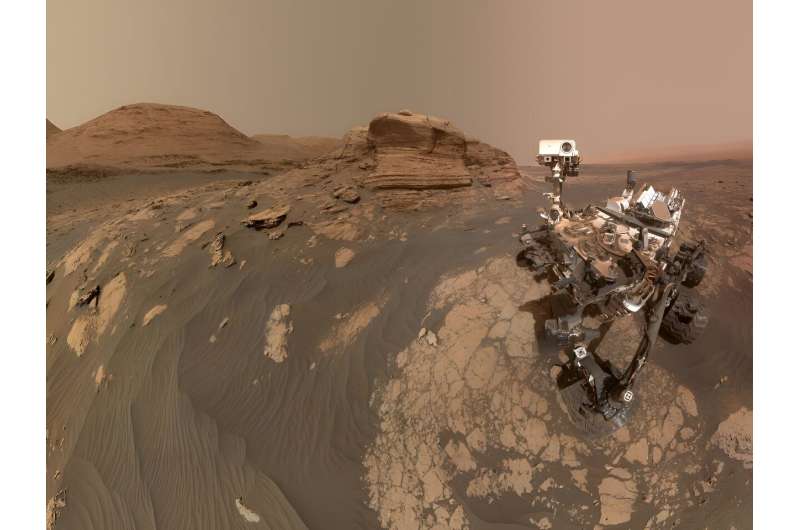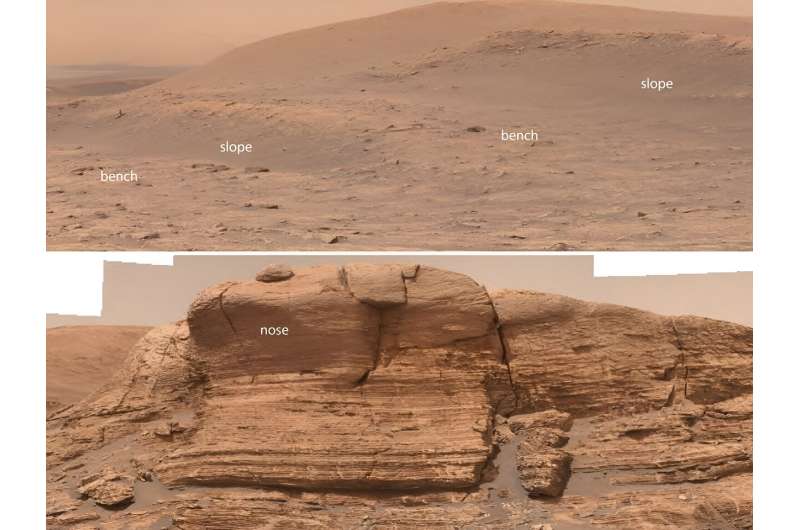This article has been reviewed according to Science X's editorial process and policies. Editors have highlighted the following attributes while ensuring the content's credibility:
fact-checked
peer-reviewed publication
trusted source
proofread
Curiosity rover finds new evidence of ancient Mars rivers, a key signal for life

New analysis of data from the Curiosity rover reveals that much of the craters on Mars today could have once been habitable rivers.
"We're finding evidence that Mars was likely a planet of rivers," said Benjamin Cardenas, assistant professor of geosciences at Penn State and lead author on a new paper announcing the discovery. "We see signs of this all over the planet."
In a study published in Geophysical Research Letters, the researchers used numerical models to simulate erosion on Mars over millennia and found that common crater formations—called bench-and-nose landforms—are most likely remnants of ancient riverbeds.
The study was the first to map the erosion of ancient Martian soil by training a computer model on a combination of satellite data, Curiosity images and 3D scans of the stratigraphy—or layers of rock, called strata, deposited over millions of years—beneath the Gulf of Mexico seafloor. The analysis revealed a new interpretation for common Martian crater formations which, until now, have never been associated with eroded river deposits.
"We have everything to learn about Mars by better understanding how these river deposits can be interpreted stratigraphically, thinking about rocks today as layers of sediment deposited over time," Cardenas said. "This analysis is not snapshot, but a record of change. What we see on Mars today is the remnants of an active geologic history, not some landscape frozen in time."

Prior studies of satellite data from Mars had identified erosional landforms called fluvial ridges as being possible candidates for ancient river deposits. Using data collected by the Curiosity rover at Gale crater, the team found signs of river deposits that are not associated with fluvial ridges, but rather bench-and-nose landforms that have never been linked to ancient river deposits.
"This suggests that there could be undiscovered river deposits elsewhere on the planet, and that an even larger section of the Martian sedimentary record could have been built by rivers during a habitable period of Mars history," Cardenas said. "On Earth, river corridors are so important for life, chemical cycles, nutrient cycles and sediment cycles. Everything is pointing to these rivers behaving similarly on Mars."
In designing their computer model, Cardenas and his team found a new use for 25-year-old scans of Earth's stratigraphy. Collected by oil companies, the scans of beneath the Gulf of Mexico seafloor provided an ideal comparison to Mars, Cardenas explained.
The team simulated Mars-like erosion using the 3D scans of actual, recorded stratigraphy on Earth. When they ran the simulation, the model revealed erosional Martian landscapes that formed topographic benches and noses, rather than fluvial ridges, appearing almost identical to landforms observed by the Curiosity rover inside the Gale crater.
"Our research indicates that Mars could have had far more rivers than previously believed, which certainly paints a more optimistic view of ancient life on Mars," Cardenas said. "It offers a vision of Mars where most of the planet once had the right conditions for life."
More information: Benjamin T. Cardenas et al, Landforms Associated With the Aspect‐Controlled Exhumation of Crater‐Filling Alluvial Strata on Mars, Geophysical Research Letters (2023). DOI: 10.1029/2023GL103618
Journal information: Geophysical Research Letters
Provided by Pennsylvania State University





















